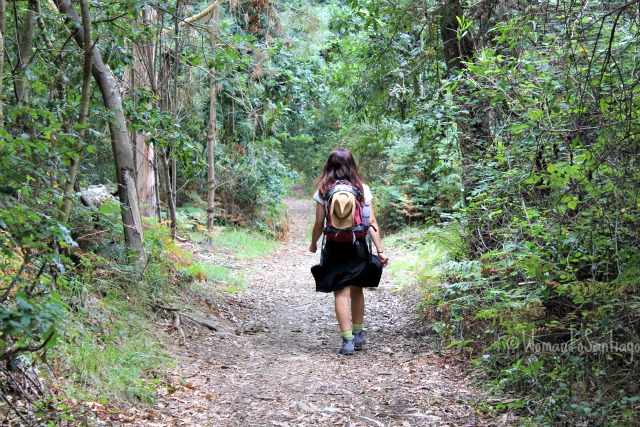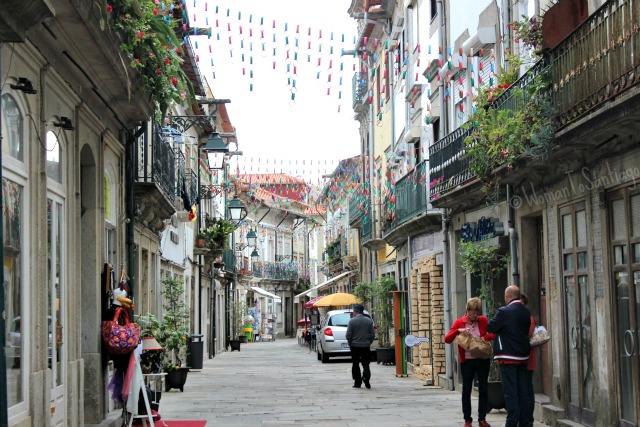El largo verano de este año aún me sorprende bien entrado diciembre, su calorcito trae buenos recuerdos de aquella etapa por tierras portuguesas que terminaba en la vieja ciudad de Viana do Castelo.
The long summer of this year still surprises me well into December, its warmth brings back great memories of that stage through the lands of Portugal which finished in the ancient city of Viana do Castelo.
Calle Vieja de Viana do Castelo
Aquel día, radiante también, comenzamos en la turística Esposende, junto al mar y a sus dunas que escondían inmensas costas de arena blanca. Tras estos escenarios de playas vírgenes para náufragos de película, nos internamos en bosques muy tupidos que decoraban la costa. Escuchábamos el murmullo del mar, podíamos olerlo, sabíamos a él, pero a través de la gran muralla verde no podíamos más que ver la senda por la que el Camino de Santiago transitaba y a la vez me recordaba las «corredoiras galleguiñas».
En esta comarca, la gente cuida el Camino como si fuera una de las partes más querida de su propio patrimonio personal. Algo que se hereda, respeta, mima y se te traslada con toda naturalidad. A mí me llegó sin duda. Te sientes parte de él, pues contribuyes con tu tránsito a forjar su propia historia. Aquí nunca un peregrino se sintió extraño fuera de su tierra y fuera del polvo de la senda que limita el Camino. El pueblo de Castelo do Neiva fue el mejor ejemplo de ello.
That day we started in the tourist city of Esposende, nearby the sea and surrounded by dunes which hid vast coast of white sand. After these landscapes of virgin beaches, we walked into dense forests of the sea coast. We listened to the whisper of the sea waves through the green wall. We could also smell it but the only thing we saw was the path of the Camino de Santiago which put me in mind of those corredoiras of Galicia.
People take care of the Camino in this area as their own. This is a tradition that was inherited and also was transmitted to me naturally. You very soon feel like youre a big part of it. You never feel oneself a stranger to this world. The town of Castelo do Neiva was the best example of this.
Iglesia de Santiago de Castelo do Neiva
Como gran colofón final y para enmarcar la etapa arribamos a la bellísima ciudad de Viana do Castelo. De nuevo peregrinos de antaño cruzando un puente metálico diseñado por Gustave Eiffel, sí, el mismo culpable de la singular torre de París. Este puente sobre el río Lima fue el último escollo antes de adentrarnos por la sublime cuadrícula de calles empedradas que conforman la urbe.
Apenas un breve descanso en un viejo hostal, pues antes incluso de llegar ya estábamos deseando participar de su ambiente. Paseamos y parecían nuestros pies descansados, adaptados a cada hueco de entre sus piedras. Y cómo cenamos aquella noche... Dejadme recordar sin prisa alguna mientras os dejo con imágenes que desde ya hace algún tiempo se encuentran grabadas más allá de este sencillo post.
De Esposende a Viana do Castelo. (Camino de Santiago Portugués por la Costa)
To round off this day we arrived to the beautiful city of Viana do Castelo. Again, pilgrims of the past crossing an old metal bridge designed by Gustave Eiffel who previously built the famous tower of Paris. This bridge over the Lima River was the last obstacle before walking into the stony streets which make up the city.
Just a short break in an old hostel due to the fact we were really looking forward to being part of that atmosphere. We walked through its streets and had dinner that night. Let me show you this scenery by way of the images captured by my camera, I hope you enjoy them as I did in the recent past.
From Esposende to Viana do Castelo. (Camino de Santiago Portugués por la Costa)
Vistas de Viana do Castelo
Puente de Gustave Eiffel sobre el río Lima
Fuente de la Plaza de la República de Viana do Castelo
Photography by Woman To Santiago
Share / Comparte
Share on twitter
follow us / Síguenos





























